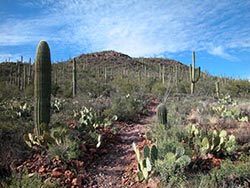Study Predicts Lag in Summer Rains Over Parts of U.S. and Mexico

A delayed monsoon could affect vegetation across the Sonoran desert, including saguaro cactuses. (Jeremy Weiss)<br>
A delay in the summer monsoon rains that fall over the southwestern United States and northwestern Mexico is expected in the coming decades according to a new study in the Journal of Geophysical Research. The North American monsoon delivers as much as 70 percent of the region's annual rainfall, watering crops and rangelands for an estimated 20 million people.
“We hope this information can be used with other studies to build realistic expectations for water resource availability in the future,” said study lead author, Benjamin Cook, a climate scientist with joint appointments at Columbia University's Lamont-Doherty Earth Observatory and the NASA Goddard Institute for Space Studies.
Much of the arid U.S. Southwest is expected to get even drier as winter precipitation declines under climate change, but the present modeling study predicts that summer rain levels will stay constant over southern Arizona and New Mexico, and northwestern Mexico. What will shift is the arrival of the heaviest rains, from July and August or so, to September and October, the study says. “There still will be a healthy monsoon which is good news for agriculture in the southern U.S. and northwestern Mexico-the timing is the problem here,” said study co-author Richard Seager, a climate scientist at Lamont-Doherty.
A delayed monsoon could potentially lower crop yields as rains come later in the growing season, when the days are getting shorter. By prolonging hot and dry conditions during spring, a late monsoon could also trigger more wildfires and force cities to stretch diminished water supplies. The study makes use of the latest climate change models (those used by the Intergovernmental Panel on Climate Change in its Fifth Assessment Report due out next fall), to estimate monthly changes in precipitation by the end of the century, 2080-2099. The researchers hypothesize that future warming will make it more difficult to form clouds and rainfall early in the monsoon when soils are dry, followed reduced winter rain and snowfall, thus delaying the onset of the monsoon rains until enough moisture can be moved in from the oceans.
There is some evidence that the monsoon may already be arriving later. A 2007 study in the Journal of Climate led by researcher Katrina Grantz, then at the University of Colorado found a decline in July rainfall since the late 1940s, and a corresponding increase in August to September rainfall. Other scientists are cautious about drawing conclusions from a relatively short instrumental record, given the monsoon's natural year-to-year variability. The second-latest monsoon onset was recorded in 2005, but for three years after, the monsoon came earlier than average or on schedule, said Chris Castro, a monsoon researcher at the University of Arizona who was not involved in the study.
The Sonoran Desert and Sky Islands ecoregion lies at the northern edge of the North American monsoon, where vegetation ranges from saguaro-studded subtropical desert in the lowlands to high-altitude boreal forests. It is unclear how plants finely attuned to the monsoon’s arrival will cope with the longer wait. “Will their growth slowdown or will some species grow dormant?” said Jeremy Weiss, a geosciences researcher at the University of Arizona who was not involved in the study.
A delay is bound to have economic impact, whether in northwestern Mexico or Arizona where agriculture and rangelands respectively are mostly rain-fed. The late monsoon in 2005 hindered summer grass development to the point that U.S. ranchers had to buy supplemental feed for their cattle, Andrea Ray, a researcher at the National Oceanic and Atmospheric Administration, noted in a 2007 study in the Journal of Climate.
Though total monsoon rainfall is projected to stay the same, warmer summer temperatures under climate change will cause more evaporation, leaving less water for crops, reservoirs and ecosystems. “It is important to look at the big picture before getting too sanguine about monsoon rainfall staying steady,” said Jonathan Overpeck, a climate scientist at the University of Arizona who was not involved in the study. “Farmers who rely on summer rain will have a trickier time as the rainfall timing and amounts changes-they like predictability. Ultimately, the jury is still out, but this is a fine study that gives us more information to plan with.”
More:
Richard Seager explains the study: Global Decadal Hydroclimate Predictability, Variability and Change: A Data-Enriched Modeling Study (GloDecH)
National Science Foundation video: North American Monsoon System.
Media Contact
More Information:
http://www.ldeo.columbia.eduAll latest news from the category: Earth Sciences
Earth Sciences (also referred to as Geosciences), which deals with basic issues surrounding our planet, plays a vital role in the area of energy and raw materials supply.
Earth Sciences comprises subjects such as geology, geography, geological informatics, paleontology, mineralogy, petrography, crystallography, geophysics, geodesy, glaciology, cartography, photogrammetry, meteorology and seismology, early-warning systems, earthquake research and polar research.
Newest articles

Silicon Carbide Innovation Alliance to drive industrial-scale semiconductor work
Known for its ability to withstand extreme environments and high voltages, silicon carbide (SiC) is a semiconducting material made up of silicon and carbon atoms arranged into crystals that is…

New SPECT/CT technique shows impressive biomarker identification
…offers increased access for prostate cancer patients. A novel SPECT/CT acquisition method can accurately detect radiopharmaceutical biodistribution in a convenient manner for prostate cancer patients, opening the door for more…

How 3D printers can give robots a soft touch
Soft skin coverings and touch sensors have emerged as a promising feature for robots that are both safer and more intuitive for human interaction, but they are expensive and difficult…




















